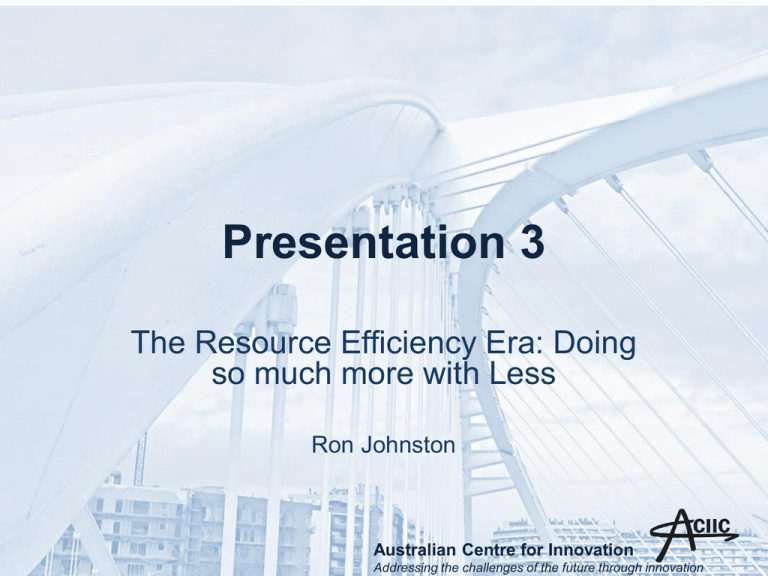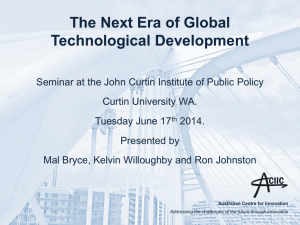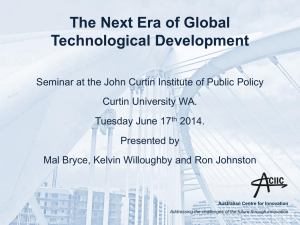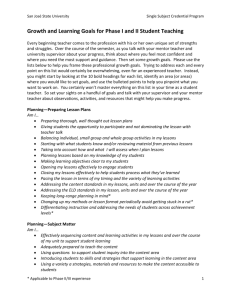Presentation 3
advertisement

Presentation 3 The Resource Efficiency Era: Doing so much more with Less Ron Johnston Australian Centre for Innovation Addressing the challenges of the future through innovation Our Understanding of Technology 1. Anything that is in the world when you are born is a natural part of the way the world works 2. Anything that is invented between when you are fifteen and forty is new, exciting and you can probably get a career out of it 3. Anything invented after you are forty is against the natural order of things Douglas Adams Australian Centre for Innovation Addressing the challenges of the future through innovation The Challenge of Predicting Technology and its Effects • • • • • • • • • • Bell’s talking telegraph only creates interest in scientific circles; as a toy it is beautiful; but its commercial value will be limited (Elisha Gray, 1876) The horse is here to stay, the automobile is a novelty (Michigan Bank manager to Henry Ford, 1908) Who the hell wants to hear actors talk? (Jack Warner, 1930) There is a world market for about five computers (Thomas Watson, IBM, 1943) Guitar music is on the way out (Decca Records rejecting Beatles, 1962) If anything will remain unchanged, it is the role of women (David Riesman, 1967) Before the year 2000 is over, the first child will have been born on the moon (Werner von Braun, 1972) The Internet is full. Go away. (T-shirt, 1995) No-one will buy anything over the Web (Newsweek, 1995) Spam will be gone within two years (Bill Gates, 2004) Australian Centre for Innovation Addressing the challenges of the future through innovation Predicting Technology and its Effects – Technological Trends and National Policy (1937) • Needs focussed, identified thirteen key technologies within a 15-20 year time horizon • Identified predicted uses, market timing and impact, and social implications • Television, facsimile transmission, air conditioning, mechanical cotton picker, synthetic rubber – essentially correct on all counts • Cotton/wool substitute and photo-electric eye – optimistic timing, different form and uses • Steep flight aircraft, prefabricated housing, automobile trailers, tray agriculture, gasoline from coal - essentially wrong on all counts Australian Centre for Innovation Addressing the challenges of the future through innovation Our Challenge (2014) • Global population growth – 2.5B in 1943, 7.2B today, 8.3-10.9 B by 2050 • 2.5B people in China, India and other developing counties will enter the ‘middle class’ by 2030 • Increased demand on already constrained resources of food, water, energy and minerals • Non-sustainability of many current industrial practices, and the growing levels of pollution and environmental degradation • Climate change Australian Centre for Innovation Addressing the challenges of the future through innovation Our Opportunity (2014) • The need to achieve a Factor Ten increase in the efficiency of resource use will be a major driver of economic activity in the next 20 years. • Factor Ten is the radical idea that humanity must reduce resource turnover by 90 percent on a global scale within the next 30 to 50 years. • To achieve dematerialisation, within the next generation human energy use must decrease by a factor of 10 while resource productivity and efficiency must increase by a factor of 10. • This will lead to transformation of resource dependency and advantage, the creation of a new technological landscape and shifts in the global factors of production. Australian Centre for Innovation Addressing the challenges of the future through innovation Sources of Factor Ten Productivity Growth • • • • Substitution – lighter stronger, cheaper, lower Waste reduction Circularity – closed-loop use of resources Optimisation – predictive and real-time analytics to reduce resource requirements and increase asset use • Virtualisation – resources as a service Heck and Rogers, Resource Revolution, Harcourt, 2014 Australian Centre for Innovation Addressing the challenges of the future through innovation Case Study – Transport Current massive inefficiencies in car-based transport Usage - 95% of time unused Fuel consumption – 86% of fuel never reaches the wheels Average occupancy – 1.6 people Motorways operating at peak capacity are less than 10% covered by cars Peak capacity is achieved only 4-5% of the day Opportunities Car sharing Smart roads New fuels - electric Efficient batteries 3-D printed manufacture Australian Centre for Innovation Addressing the challenges of the future through innovation Case Study – Smart Agriculture • Networks of low-cost sensors, actuators and wireless networks for data collection and process monitoring of crops and livestock • Robots with enhanced senses, dexterity, and intelligence used to automate tasks, such as harvesting fruit and controlling weeds and pests • Vehicles that can navigate and operate with reduced or no human control to herd livestock and harvest crops • The simulation of real-time agricultural processes using data and algorithms • Inexpensive and capable mobile computing devices with high-speed internet connectivity to the farmer in the field • Intelligent software that can perform farm planning tasks, and support decision-making and optimize large-scale production processes. Australian Centre for Innovation Addressing the challenges of the future through innovation Case Study – and Smart Food • Smart packaging to enhance life and detect breakdown • Interactive labelling to advise on nutrition, energy load, etc • Food tracking and management systems to minimise wastage • Decentralised and localised food production (vertical gardens) Australian Centre for Innovation Addressing the challenges of the future through innovation











